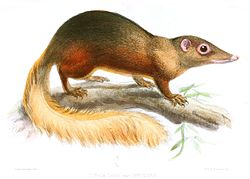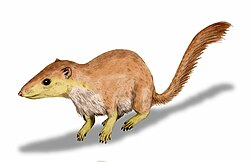| Dendrogale | |
|---|---|
| Scientific classification | |
| Domain: | Eukaryota |
| Kingdom: | Animalia |
| Phylum: | Chordata |
| Class: | Mammalia |
| Order: | Scandentia |
| Family: | Tupaiidae |
| Genus: | Dendrogale J. E. Gray, 1848 |
| Type species | |
| Hylogalea murina | |
| Species | |
 | |
Dendrogale is a genus of treeshrew in the family Tupaiidae found in Southeast Asia and Borneo. [1] It contains these species:
- Bornean smooth-tailed treeshrew (D. melanura)
- Northern smooth-tailed treeshrew (D. murina)
Dendrogale diverged from the rest of the Tupaiidae family at 34.77 mya, and is considered the most basal tupaiid genus. [2]




